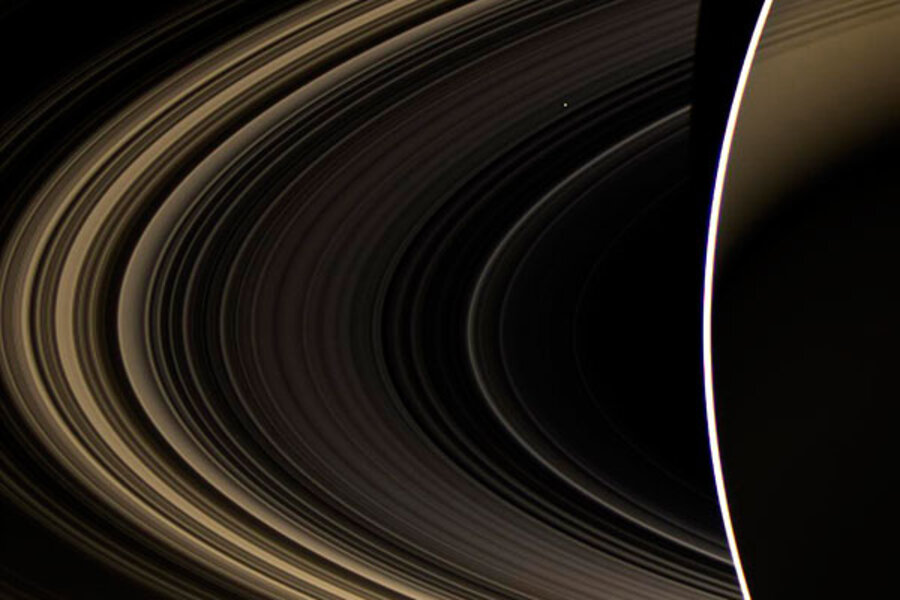Where did Saturn's rings come from? Mystery gets a new clue.
Loading...
New evidence from the US-European Cassini mission to Saturn suggests a very early birth for ices in Saturn’s spectacular system of rings and moonlets, dating back to shortly after the planet itself formed.
The results deepen a mystery that has bedeviled Saturn watchers since Galileo first spotted what later would be interpreted as rings in 1610: How did the rings form? And, more recently, what sustains the ring system?
“No one actually knows why the rings can survive for 4.5 billion years,” says Scott Kenyon, an astronomer at the Harvard-Smithsonian Center for Astrophysics in Cambridge, Mass. “At the moment, we don’t have a good model” that explains this longevity.
The apparently implausible life span of the ring system has led some researchers to propose that the system didn’t form shortly after the planet did.
Instead, it might have formed perhaps 100 million years ago. The raw material for the rings and moonlets could have come from the debris spawned by a collision between close-in moons, or between a close-in moon and a comet.
But the recent-ring scenario has had a troubled existence.
In 2007, for example, scientists reported evidence from Cassini’s Ultraviolet Imaging Spectrometer indicating that the rings had significant age differences and that the material in the rings was constantly being recycled as moonlets collided. Some of the debris later would form into new moonlets.
That evidence didn’t support a single, recent violent encounter between objects as a source of material for the ring system.
Now, researchers using another of Cassini’s instruments, the Visual and Infrared Mapping Spectrometer (VIMS), have uncovered further evidence for this recycling as they have mapped changes in the composition of the ring material and moonlets that form a 40,800-mile-wide band around the planet.
Perhaps more important, Cassini has uncovered far more water ice in the system than comets could deliver.
The system “is very ice rich,” says Bonnie Buratti, a researcher at NASA’s Jet Propulsion Laboratory in Pasadena, Calif., and a member of the VIMS team.
To Dr. Kenyon, the results showing ices throughout the system speak to a primeval origin.
“All of the stuff inside the really major moons is composed of the same stuff as the major moons,” he says. “That’s really nice to know because that tells you the rings are 4.5 billion years old.”
But that still leaves the question of longevity.
Left to their own devices, the moonlets would migrate ever farther from Saturn, leaving the ring system within perhaps 100 million years or so.
Cassini has revealed that moonlets form from material that accretes at the outer edges of the rings, explains Phillip Nicholson, an astronomer at Cornell University in Ithaca, N.Y., and a member of the team reporting the VIMS results this week in the Astrophysical Journal.
One possible solution to the conundrum would be to give the ring system more initial mass than researchers have presumed.
Modeling work by Robin Canup, a scientist at the Southwest Research Institute in Boulder, Colo., has suggested that some 2 million to 5 million years after it formed, Saturn had – and devoured – several moons the size of Titan, the planet’s largest existing satellite. But these other Titan-scale moons orbited too close to the planet to survive.
As they were drawn to their doom, the tidal forces Saturn exerted on the last victim stripped a thick icy crust and mantle from the moon’s rocky core. The ice broke up to begin forming a ring, while the core continued its death spiral into the planet.
Such a ring would have hosted far more mass than today’s rings do, according to the study, published in 2010.
The ring in the modeling also mimicked observed ring behaviors: losing mass over time while forming moons at the outer edges of the ring, for instance. The moons it formed were similar in mass to the icy moons out to and including Tethys.
The hope is that a knowledge of the composition of ring material and the moonlets in Saturn’s ring system will shed light on the ring-forming process.
Cassini launched as the Cassini-Huygens mission in October 1997 and began orbiting Saturn in July 2004. The following December, the spacecraft released the European Space Agency’s Huygens probe toward a successful landing on Saturn’s moon Titan. Since then, the orbiter has been touring the planet’s moons and rings, giving researchers an unprecedented look at the Saturn system.







